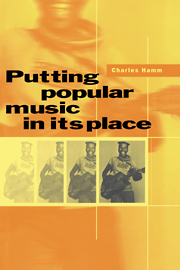Book contents
- Frontmatter
- Contents
- Acknowledgements
- Preface
- 1 Modernist narratives and popular music
- 2 Rock and the facts of life
- 3 Changing patterns in society and music: the US since World War II
- 4 “If I Were a Voice”: or, The Hutchinson Family and popular song as political and social protest
- 5 Some thoughts on the measurement of popularity in music
- 6 Elvis, a review
- 7 Home cooking and American soul in black South African popular music
- 8 Rock ‘n’ roll in a very strange society
- 9 African-American music, South Africa, and apartheid
- 10 “The constant companion of man”: Separate Development, Radio Bantu, and music
- 11 Privileging the moment of reception: music and radio in South Africa
- 12 Music and radio in the People's Republic of China
- 13 Towards a new reading of Gershwin
- 14 A blues for the ages
- 15 Graceland revisited
- 16 Dvořák in America: nationalism, racism, and national race
- 17 The last minstrel show?
- 18 The Role of Rock, a review
- 19 Genre, performance, and ideology in the early songs of Irving Berlin
- 20 Epilogue: John Cage revisited
- Index
2 - Rock and the facts of life
Published online by Cambridge University Press: 05 February 2012
- Frontmatter
- Contents
- Acknowledgements
- Preface
- 1 Modernist narratives and popular music
- 2 Rock and the facts of life
- 3 Changing patterns in society and music: the US since World War II
- 4 “If I Were a Voice”: or, The Hutchinson Family and popular song as political and social protest
- 5 Some thoughts on the measurement of popularity in music
- 6 Elvis, a review
- 7 Home cooking and American soul in black South African popular music
- 8 Rock ‘n’ roll in a very strange society
- 9 African-American music, South Africa, and apartheid
- 10 “The constant companion of man”: Separate Development, Radio Bantu, and music
- 11 Privileging the moment of reception: music and radio in South Africa
- 12 Music and radio in the People's Republic of China
- 13 Towards a new reading of Gershwin
- 14 A blues for the ages
- 15 Graceland revisited
- 16 Dvořák in America: nationalism, racism, and national race
- 17 The last minstrel show?
- 18 The Role of Rock, a review
- 19 Genre, performance, and ideology in the early songs of Irving Berlin
- 20 Epilogue: John Cage revisited
- Index
Summary
When I arrived at Princeton University to begin work on a Ph.D. in musicology in 1957, with a life-long interest and involvement in various genres of American music, I discovered that:
All books, monographs, editions, periodicals, and other materials considered necessary for successfully completing the degree had been collected in a large study-seminar room.… The word “canon” was never used then, but the ideology, though never articulated, could not have been clearer. The corpus of music and literature on music necessary for the pursuit of musicology was finite; it was all here in this room; and once our apprenticeship was completed and we moved out into the hard world of academia, our success would be measured by whether or not our own work would one day be brought into this room.
The [general] stacks were situated just outside the door of our sanctuary, and occasionally, when none of my professors or fellow students was about, I would sneak a look at a score by John Cage or Charles Ives, or at a book about southern folk hymnody, or a bound collection of nineteenth-century sheet music. I felt like a teenager browsing through a collection of pornography.
What Wiley Hitchcock would later label “vernacular music” was no part of this canon, and my proposal to write a dissertation on nineteenth-century shape-note music was rejected out of hand.
- Type
- Chapter
- Information
- Putting Popular Music in its Place , pp. 41 - 54Publisher: Cambridge University PressPrint publication year: 1995

